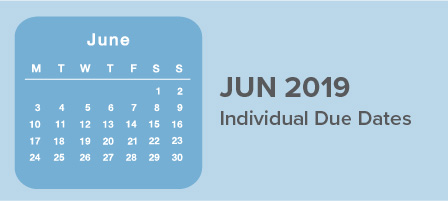JUNE 2019 INDIVIDUAL DUE DATES
June 10 – Report Tips to Employer
If you are an employee who works for tips and received more than $20 in tips during May, you are required to report them to your employer on IRS Form 4070 no later than June 10. Your employer is required to withhold FICA taxes and income tax withholding for these tips from your regular wages. If your regular wages are insufficient to cover the FICA and tax withholding, the employer will report the amount of the uncollected withholding in box 12 of your W-2 for the year. You will be required to pay the uncollected withholding when your return for the year is filed.
June 17 – Estimated Tax Payment Due
It’s time to make your second quarter estimated tax installment payment for the 2019 tax year. Our tax system is a “pay-as-you-earn” system. To facilitate that concept, the government has provided several means of assisting taxpayers in meeting the “pay-as-you-earn” requirement. These include:
- Payroll withholding for employees;
- Pension withholding for retirees; and
- Estimated tax payments for self-employed individuals and those with other sources of income not covered by withholding.
When a taxpayer fails to prepay a safe harbor (minimum) amount, they can be subject to the underpayment penalty. This penalty is equal to the federal short-term rate plus 3 percentage points, and the penalty is computed on a quarter-by-quarter basis.
Federal tax law does provide ways to avoid the underpayment penalty. If the underpayment is less than $1,000 (the “de minimis amount”), no penalty is assessed. In addition, the law provides “safe harbor” prepayments. There are two safe harbors:
- The first safe harbor is based on the tax owed in the current year. If your payments equal or exceed 90% of what is owed in the current year, you can escape a penalty.
- The second safe harbor is based on the tax owed in the immediately preceding tax year. This safe harbor is generally 100% of the prior year’s tax liability. However, for taxpayers whose AGI exceeds $150,000 ($75,000 for married taxpayers filing separately), the prior year’s safe harbor is 110%.
Example: Suppose your tax for the year is $10,000 and your prepayments total $5,600. The result is that you owe an additional $4,400 on your tax return. To find out if you owe a penalty, see if you meet the first safe harbor exception. Since 90% of $10,000 is $9,000, your prepayments fell short of the mark. You can’t avoid the penalty under this exception.
However, in the above example, the safe harbor may still apply. Assume your prior year’s tax was $5,000. Since you prepaid $5,600, which is greater than 110% of the prior year’s tax (110% = $5,500), you qualify for this safe harbor and can escape the penalty.
This example underscores the importance of making sure your prepayments are adequate, especially if you have a large increase in income. This is common when there is a large gain from the sale of stocks, sale of property, when large bonuses are paid, when a taxpayer retires, etc. Timely payment of each required estimated tax installment is also a requirement to meet the safe harbor exception to the penalty. If you have questions regarding your safe harbor estimates, please call this office as soon as possible.
CAUTION: Some state de minimis amounts and safe harbor estimate rules are different than those for the Federal estimates. Please call this office for particular state safe harbor rules.
June 17 – Taxpayers Living Abroad
If you are a U.S. citizen or resident alien living and working (or on military duty) outside the United States and Puerto Rico, June 17 is the filing due date for your 2018 income tax return and to pay any tax due. If your return has not been completed and you need additional time to file your return, file Form 4868 to obtain 4 additional months to file. Then, file Form 1040 by October 15. However, if you are a participant in a combat zone, you may be able to further extend the filing deadline (see below).
Caution: This is not an extension of time to pay your tax liability, only an extension to file the return. If you expect to owe, estimate how much and include your payment with the extension. If you owe taxes when you do file your extended tax return, you will be liable for both the late payment penalty and interest from the due date.
Combat Zone – For military taxpayers in a combat zone/qualified hazardous duty area, the deadlines for taking actions with the IRS are extended. This also applies to service members involved in contingency operations, such as Operation Iraqi Freedom or Enduring Freedom. The extension is for 180 consecutive days after the later of:
- The last day a military taxpayer was in a combat zone/qualified hazardous duty area or served in a qualifying contingency operation, or have qualifying service outside of the combat zone/qualified hazardous duty area (or the last day the area qualifies as a combat zone or qualified hazardous duty area), or
- The last day of any continuous qualified hospitalization for injury from service in the combat zone/qualified hazardous duty area or contingency operation, or while performing qualifying service outside of the combat zone/qualified hazardous duty area.
In addition to the 180 days, the deadline is also extended by the number of days that were left for the individual to take an action with the IRS when they entered a combat zone/qualified hazardous duty area or began serving in a contingency operation.
It is not a good idea to delay filing your return because you owe taxes. The late filing penalty is 5% per month (maximum 25%) and can be a substantial penalty. It is generally better practice to file the return without payment and avoid the late filing penalty. We can also establish an installment agreement, which allows you to pay your taxes over a period of up to 72 months.
Please contact this office for assistance with an extension request or an installment agreement.









Leave a Reply
Want to join the discussion?Feel free to contribute!